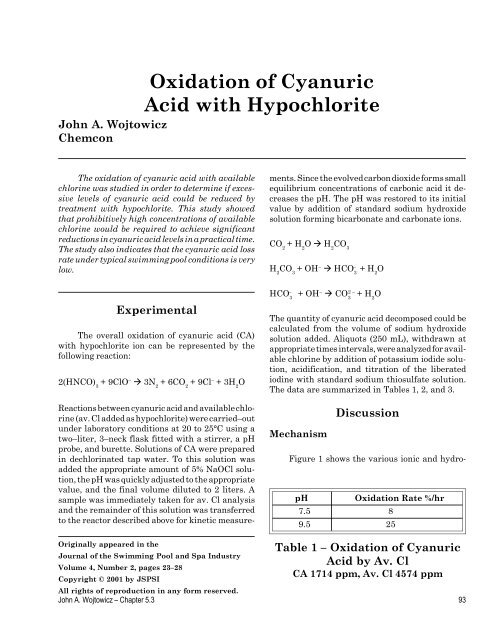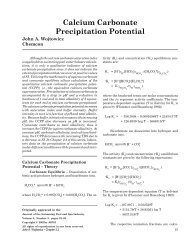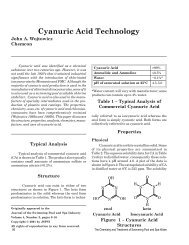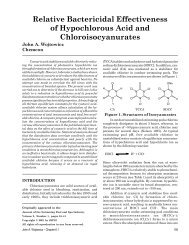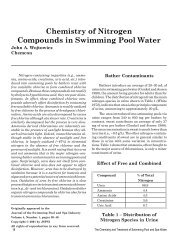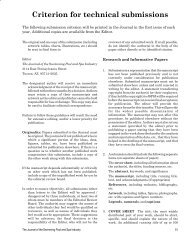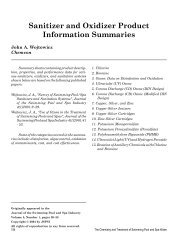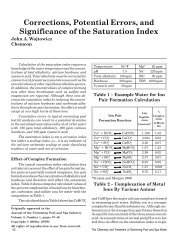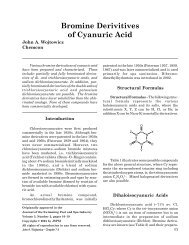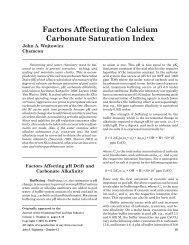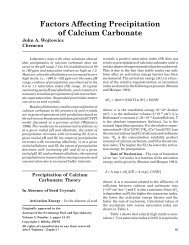Oxidation of Cyanuric Acid with Hypochlorite - The Journal of the ...
Oxidation of Cyanuric Acid with Hypochlorite - The Journal of the ...
Oxidation of Cyanuric Acid with Hypochlorite - The Journal of the ...
Create successful ePaper yourself
Turn your PDF publications into a flip-book with our unique Google optimized e-Paper software.
<strong>Oxidation</strong> <strong>of</strong> <strong>Cyanuric</strong><br />
<strong>Acid</strong> <strong>with</strong> <strong>Hypochlorite</strong><br />
John A. Wojtowicz<br />
Chemcon<br />
<strong>The</strong> oxidation <strong>of</strong> cyanuric acid <strong>with</strong> available<br />
chlorine was studied in order to determine if excessive<br />
levels <strong>of</strong> cyanuric acid could be reduced by<br />
treatment <strong>with</strong> hypochlorite. This study showed<br />
that prohibitively high concentrations <strong>of</strong> available<br />
chlorine would be required to achieve significant<br />
reductions in cyanuric acid levels in a practical time.<br />
<strong>The</strong> study also indicates that <strong>the</strong> cyanuric acid loss<br />
rate under typical swimming pool conditions is very<br />
low.<br />
ments. Since <strong>the</strong> evolved carbon dioxide forms small<br />
equilibrium concentrations <strong>of</strong> carbonic acid it decreases<br />
<strong>the</strong> pH. <strong>The</strong> pH was restored to its initial<br />
value by addition <strong>of</strong> standard sodium hydroxide<br />
solution forming bicarbonate and carbonate ions.<br />
CO 2<br />
+ H 2<br />
O à H 2<br />
CO 3<br />
H 2<br />
CO 3<br />
+ OH – à HCO 3<br />
–<br />
+ H 2<br />
O<br />
Experimental<br />
<strong>The</strong> overall oxidation <strong>of</strong> cyanuric acid (CA)<br />
<strong>with</strong> hypochlorite ion can be represented by <strong>the</strong><br />
following reaction:<br />
2(HNCO) 3<br />
+ 9ClO – à 3N 2<br />
+ 6CO 2<br />
+ 9Cl – + 3H 2<br />
O<br />
Reactions between cyanuric acid and available chlorine<br />
(av. Cl added as hypochlorite) were carried–out<br />
under laboratory conditions at 20 to 25°C using a<br />
two–liter, 3–neck flask fitted <strong>with</strong> a stirrer, a pH<br />
probe, and burette. Solutions <strong>of</strong> CA were prepared<br />
in dechlorinated tap water. To this solution was<br />
added <strong>the</strong> appropriate amount <strong>of</strong> 5% NaOCl solution,<br />
<strong>the</strong> pH was quickly adjusted to <strong>the</strong> appropriate<br />
value, and <strong>the</strong> final volume diluted to 2 liters. A<br />
sample was immediately taken for av. Cl analysis<br />
and <strong>the</strong> remainder <strong>of</strong> this solution was transferred<br />
to <strong>the</strong> reactor described above for kinetic measure-<br />
HCO 3<br />
–<br />
+ OH – à CO 3<br />
2 –<br />
+ H 2<br />
O<br />
<strong>The</strong> quantity <strong>of</strong> cyanuric acid decomposed could be<br />
calculated from <strong>the</strong> volume <strong>of</strong> sodium hydroxide<br />
solution added. Aliquots (250 mL), <strong>with</strong>drawn at<br />
appropriate times intervals, were analyzed for available<br />
chlorine by addition <strong>of</strong> potassium iodide solution,<br />
acidification, and titration <strong>of</strong> <strong>the</strong> liberated<br />
iodine <strong>with</strong> standard sodium thiosulfate solution.<br />
<strong>The</strong> data are summarized in Tables 1, 2, and 3.<br />
Mechanism<br />
Discussion<br />
Figure 1 shows <strong>the</strong> various ionic and hydropH<br />
7.5 8<br />
9.5 25<br />
<strong>Oxidation</strong> Rate %/hr<br />
Originally appeared in <strong>the</strong><br />
<strong>Journal</strong> <strong>of</strong> <strong>the</strong> Swimming Pool and Spa Industry<br />
Volume 4, Number 2, pages 23–28<br />
Copyright © 2001 by JSPSI<br />
Table 1 – <strong>Oxidation</strong> <strong>of</strong> <strong>Cyanuric</strong><br />
<strong>Acid</strong> by Av. Cl<br />
CA 1714 ppm, Av. Cl 4574 ppm<br />
All rights <strong>of</strong> reproduction in any form reserved.<br />
John A. Wojtowicz – Chapter 5.3 93
CA Time (h) mL Na 2<br />
S 2<br />
O 3<br />
(V) Av. Cl B a/(a - x) k<br />
ppm N=0.02 A ppm hour -1<br />
1714 0 40.30 572.26 1<br />
0.5 39.30 558.06 1.025<br />
2.6 38.04 540.17 1.059<br />
8.5 34.55 490.61 1.166<br />
14.7 31.45 446.59 1.261 0.0163<br />
171.8 0 20.65 58.65 1<br />
5 18.40 52.26 1.122<br />
12 16.80 47.71 1.229<br />
28 14.05 39.90 1.47<br />
46 10.80 30.67 1.92 0.0135<br />
85.9 0 10.33 29.34 1<br />
7 8.90 25.28 1.161<br />
23 7.53 21.39 1.372<br />
41 5.70 16.19 1.812<br />
63 4.05 11.50 2.551 0.0145<br />
43 0 5.16 14.65 1<br />
7 4.40 12.50 1.173<br />
23 3.75 10.65 1.376<br />
41 2.78 7.90 1.856<br />
63 1.95 5.54 2.646 0.0150<br />
21.5 0 2.58 7.33 1<br />
7 2.13 6.05 1.211<br />
23 1.87 5.31 1.38<br />
41 1.43 4.06 1.804<br />
63 1.00 2.84 2.58 0.0143<br />
Average 0.0147<br />
Std. Dev. 0.0010<br />
A. N = 0.1 in run 1<br />
B. Av. Cl = VN(0.0355)(10 3 )/0.25<br />
Table 2 – <strong>Oxidation</strong> <strong>of</strong> <strong>Cyanuric</strong> <strong>Acid</strong> by Available Chlorine<br />
94 <strong>The</strong> Chemistry and Treatment <strong>of</strong> Swimming Pool and Spa Water
Hydrolysis à<br />
Initial CA Initial Av. Cl Rate Constant k Calc’d. Initial DCA<br />
ppm ppm h –1 ppm/day<br />
1714 571.5 0.0163 74.9<br />
171.8 58.6 0.0135 6.6<br />
85.9* 29.3 0.0145 3.5<br />
43.0 14.7 0.0153 1.8<br />
21.5 7.33 0.0143 0.9<br />
Average 0.0147<br />
Table 3 – Decomposition <strong>of</strong> <strong>Cyanuric</strong> <strong>Acid</strong> by <strong>Hypochlorite</strong><br />
pH 7.5, T = 20–25°C<br />
lytic equilibria in a cyanuric acid–available chlorine<br />
system. A knowledge <strong>of</strong> all <strong>of</strong> <strong>the</strong> equilibrium<br />
constants allows calculation <strong>of</strong> <strong>the</strong> concentration <strong>of</strong><br />
individual species as a function pH. <strong>The</strong> plot in<br />
Figure 2 shows calculated species concentrations<br />
for water containing 1,714 ppm CA and 4,574 av. Cl.<br />
It shows that <strong>the</strong> dichloroisocyanurate (Cl 2<br />
Cy – ) and<br />
hypochlorite ions are <strong>the</strong> main species from a concentration<br />
standpoint beyond pH 7.5.<br />
<strong>The</strong> primary step in decomposition <strong>of</strong> cyanuric<br />
acid by available chlorine involves cleavage <strong>of</strong> <strong>the</strong><br />
triazine ring. Cleavage <strong>of</strong> <strong>the</strong> triazine ring <strong>of</strong><br />
isocyanurates is generally believed to involve nucleophilic<br />
attack (by a nucleophile) at a carbonyl<br />
carbon atom. A nucleophile (e.g., ClO – or OH – ) is an<br />
electron–rich ion or molecule that donates an electron<br />
pair to an atom resulting in formation <strong>of</strong> a<br />
covalent bond. It is most likely that <strong>the</strong> molecule<br />
attacked in <strong>the</strong> ring cleavage reaction is fully chlorinated,<br />
ie, dichloroisocyanurate ion. Ring opening<br />
followed by reaction <strong>with</strong> av. Cl would yield N 2<br />
, Cl – ,<br />
CO 2<br />
, and H 2<br />
O via intermediate formation <strong>of</strong> NCl 3<br />
as<br />
shown below. Studies on decomposition <strong>of</strong> sodium<br />
dichloroisocyanurate solutions showed that it’s decomposition<br />
was first order <strong>with</strong> respect to av. Cl,<br />
increased <strong>with</strong> pH, and also involved intermediate<br />
formation <strong>of</strong> NCl 3<br />
. <strong>The</strong> following sequence <strong>of</strong> reactions<br />
is believed to represent <strong>the</strong> main features <strong>of</strong><br />
<strong>the</strong> oxidation <strong>of</strong> CA by av. Cl.<br />
H 3<br />
Cy à H 2<br />
Cy – + H +<br />
Cl 3<br />
Cy<br />
K 1<br />
K 2<br />
HCl 2<br />
Cy Cl 2<br />
Cy –<br />
H 2<br />
Cy – + 2ClO – à Cl 2<br />
Cy – + 2OH –<br />
Cl 2<br />
Cy – + 7ClO – + 4H 2<br />
O à<br />
3NCl 3<br />
+ 2CO 2<br />
+ HCO 3<br />
–<br />
+ 7OH –<br />
K 3<br />
K 7<br />
K 4<br />
K 8<br />
H 2<br />
ClCy HClCy – ClCy 2–<br />
3NCl 3<br />
+ 9OH – à 1.5N 2<br />
+ 4.5ClO – + 4.5Cl – + 4.5H 2<br />
O<br />
HCO 3<br />
–<br />
+ H + à CO 2<br />
+ H 2<br />
O<br />
K 5<br />
K 9<br />
K 11<br />
K 6<br />
K 10<br />
K 12<br />
H 3<br />
Cy H 2<br />
Cy – HCy 2– Cy 3–<br />
Dissociation à<br />
Figure 1 – Equilibria Among<br />
<strong>Cyanuric</strong> <strong>Acid</strong> and its<br />
Chlorinated Derivitives*<br />
*an additional equilibrium<br />
Overall:<br />
H 3<br />
Cy + 4.5ClO – à 1.5N 2<br />
+ 4.5Cl – + 3CO 2<br />
+ 1.5H 2<br />
O<br />
Stoichiometric Reaction<br />
<strong>The</strong> oxidation <strong>of</strong> cyanuric acid was initially<br />
is: HOCl H + + ClO –<br />
carried–out using a slight excess <strong>of</strong> available chlorine<br />
over <strong>the</strong> stoiochiometric molar ratio <strong>of</strong> avail-<br />
John A. Wojtowicz – Chapter 5.3 95
Figure 2 – Species Distribution in <strong>the</strong> CA/Av. Cl<br />
able chlorine to cyanuric acid, i.e., 4.9 vs. 4.5. <strong>The</strong><br />
reaction was shown to be first order (i.e., a linear<br />
function) <strong>with</strong> respect to <strong>the</strong> cyanuric acid and<br />
available chlorine concentrations. <strong>The</strong> data in Table<br />
1 show that cyanuric acid is oxidized at an initial<br />
rate <strong>of</strong> ~8%/hour at pH 7.5 and threefold faster at<br />
pH 9.5.<br />
Whereas <strong>the</strong> dichloroisocyanurate ion concentration<br />
remains essentially constant, <strong>the</strong> concentration<br />
<strong>of</strong> hypochlorite ion increases tw<strong>of</strong>old over<br />
<strong>the</strong> 7.5 to 9.5 pH range. This can explain most <strong>of</strong> <strong>the</strong><br />
increase in <strong>the</strong> decomposition rate <strong>of</strong> cyanuric acid<br />
over <strong>the</strong> same pH range. Figure 2 shows that <strong>the</strong><br />
concentration <strong>of</strong> dichloroisocyanurate ion decreases<br />
beyond pH 9.5 so that if <strong>the</strong> assumed mechanism is<br />
correct, <strong>the</strong> initial rate <strong>of</strong> decomposition <strong>of</strong> cyanuric<br />
acid should decrease beyond that pH. This has been<br />
observed (Carlson 1978).<br />
<strong>The</strong> effect <strong>of</strong> temperature was studied by<br />
Carlson (1978) over <strong>the</strong> 12 to 35°C range at pH 9.5<br />
and a 4.8 NaOCl/CA molar ratio; initial CA concentration<br />
was 1714 ppm. Analysis <strong>of</strong> his data indicates<br />
an activation energy <strong>of</strong> 10,934 calories, which means<br />
that <strong>the</strong> reaction rate approximately doubles for<br />
each 10ºC rise in temperature.<br />
Substoichiometric Reaction<br />
av. Cl/CA (from 4.9 to 0.6) resulted in a 15–fold<br />
decrease (from 8.6 to 0.6%/h) in <strong>the</strong> initial cyanuric<br />
acid decomposition rate at pH 7.5. Additional experiments<br />
showed that fur<strong>the</strong>r reductions in concentration<br />
at a constant av. Cl/CA molar ratio equal<br />
to 0.6 produced a linear decrease in <strong>the</strong> cyanuric<br />
acid decomposition rate and gave reproducible rate<br />
constants over an 80–fold concentration range as<br />
shown in Table 3.<br />
Kinetics – <strong>The</strong> rate <strong>of</strong> oxidation <strong>of</strong> CA is<br />
related to <strong>the</strong> loss <strong>of</strong> av. Cl by <strong>the</strong> following equation:<br />
1. dCA/dt = (1/4.5)d(av. Cl)/dt<br />
where dCA, d(av. Cl), and dt are differentials that<br />
represent infinitesimal changes in <strong>the</strong> CA and av.<br />
Cl concentrations and time t.<br />
<strong>The</strong> rate <strong>of</strong> consumption <strong>of</strong> av. Cl is given by <strong>the</strong><br />
following equation:<br />
2. d(av. Cl)/dt = k[av. Cl]<br />
where k is a specific rate constant (ie, <strong>the</strong> rate <strong>of</strong><br />
reaction at unit concentration <strong>of</strong> av. Cl).<br />
An eight–fold reduction in <strong>the</strong> mol ratio<br />
If <strong>the</strong> av. Cl concentration is equal to (a – x), where<br />
96 <strong>The</strong> Chemistry and Treatment <strong>of</strong> Swimming Pool and Spa Water
a is <strong>the</strong> initial concentration and x is <strong>the</strong> amount<br />
that has decomposed, equation 2 becomes:<br />
3. –dx/dt = k(a–x)<br />
where dx represents <strong>the</strong> infinitesimal change in x.<br />
Integration (i.e., conversion <strong>of</strong> <strong>the</strong> differential equation<br />
to an algabraic equation by a process <strong>of</strong> summation)<br />
and application <strong>of</strong> boundary conditions (i.e.,<br />
placing limits on <strong>the</strong> value <strong>of</strong> x at time 0 and time t)<br />
gives <strong>the</strong> following equation for <strong>the</strong> loss <strong>of</strong> available<br />
chlorine (x) <strong>with</strong> time (t) as a function <strong>of</strong> <strong>the</strong> initial<br />
concentration <strong>of</strong> available chlorine (a) at pH 7.5 and<br />
a ppm CA/ppm av. Cl ratio <strong>of</strong> 3.0.<br />
4. Log [a/(a – x)] = 0.4343kt<br />
Equation 4 is <strong>of</strong> <strong>the</strong> form y = mx. Data and<br />
calculated values <strong>of</strong> a/(a – x) for all experiments are<br />
shown in Table 2. A plot <strong>of</strong> Log [a/(a – x)] against<br />
time (Figure 3) should give a straight line <strong>with</strong> a<br />
slope m equal to 0.4343k. Dividing <strong>the</strong> actual slope<br />
by 0.4343 yields <strong>the</strong> value <strong>of</strong> k. <strong>The</strong> average value <strong>of</strong><br />
k is 0.0147 ± 0.0010 h –1 at 20 to 25ºC<br />
Raising both sides <strong>of</strong> equation 4 to <strong>the</strong> power <strong>of</strong><br />
ten, and since x = D av. Cl (where D represents a<br />
change in concentration) and a = [av. Cl] i<br />
, this<br />
equation can be rearranged to:<br />
This equation can be converted to an equation for<br />
loss <strong>of</strong> cyanuric acid by substituting <strong>the</strong> following<br />
expression: D av. Cl = (DCA •71•4.5)/129<br />
6. DCA = 0.404[av. Cl] i<br />
(1 – 10 –0.4343kt )<br />
Substitution <strong>of</strong> <strong>the</strong> available chlorine concentration<br />
(ppm) and <strong>the</strong> time (hours) gives <strong>the</strong> cyanuric acid<br />
decomposition rate. A summary <strong>of</strong> <strong>the</strong> rate constant<br />
data and calculated values <strong>of</strong> <strong>the</strong> initial cyanuric<br />
acid decomposition rate are shown in Table 3.<br />
An equation for calculating <strong>the</strong> CA decomposition<br />
rate at a relatively steady average av. Cl concentration<br />
can be obtained by a modification <strong>of</strong><br />
equation 1:<br />
7. DCA = 0.404k[av. Cl] AVG<br />
Dt<br />
Implications for Swimming Pools and<br />
Spas – <strong>The</strong> data in Table 3 show that at a cyanuric<br />
acid concentration <strong>of</strong> 172 ppm and an available<br />
chlorine concentration <strong>of</strong> 59 ppm, that <strong>the</strong> initial<br />
cyanuric acid decomposition rate is only about 7<br />
ppm/day at 20–25°C. <strong>The</strong> effect <strong>of</strong> temperature on<br />
<strong>the</strong> cyanuric acid decomposition rate can be calculated<br />
by means <strong>of</strong> <strong>the</strong> following equation:<br />
8. Log (R 2<br />
/R 1<br />
) = 2389(1/T 1<br />
–1/T 2<br />
)<br />
5. D av. Cl = [av. Cl] i<br />
(1 – 10 –0.4343kt )<br />
Figure 3 – First Order Plot for Reaction <strong>of</strong> CA <strong>with</strong> Av. Cl.<br />
John A. Wojtowicz – Chapter 5.3 97
where R 1<br />
and R 2<br />
are <strong>the</strong> cyanuric acid decomposition<br />
rates at absolute temperatures T 1<br />
and T 2<br />
. At a<br />
swimming pool temperature <strong>of</strong> 80°F (i.e., 26.6°C)<br />
cyanuric acid decomposition rate would be approximately<br />
1.3 times greater, while at a spa temperature<br />
<strong>of</strong> 104°F (40ºC), it would be 2.8 times greater<br />
than shown in Table 3 above.<br />
Even if <strong>the</strong> cyanuric acid and available chlorine<br />
concentrations were doubled to 344 and 118<br />
ppm, <strong>the</strong> initial decomposition rate would be increased<br />
to only 18 and 38 ppm/day for pools and<br />
spas, respectively. <strong>The</strong>se initial rates would decrease<br />
as <strong>the</strong> concentrations <strong>of</strong> cyanuric acid and<br />
available chlorine decreased. In order to maintain<br />
<strong>the</strong> initial cyanuric acid decomposition rate one<br />
would have to not only replenish <strong>the</strong> available<br />
chlorine that had decomposed in <strong>the</strong> first day but<br />
also add an additional amount to compensate for<br />
<strong>the</strong> reduced rate <strong>of</strong> reaction caused by <strong>the</strong> decreased<br />
cyanuric acid concentration.<br />
<strong>The</strong> high available chlorine concentration<br />
would present a potential corrosion problem for <strong>the</strong><br />
pool’s recirculation system components and might<br />
also bleach vinyl pool liners. Thus, oxidation <strong>of</strong><br />
cyanuric acid by hypochlorite does not appear to be<br />
a practical method for reducing excessive levels <strong>of</strong><br />
cyanuric acid. Partial replacement <strong>of</strong> <strong>the</strong> pool water<br />
is a much better alternative.<br />
Equations 6 and 7 may not accurately predict<br />
<strong>the</strong> decomposition rate <strong>of</strong> CA under typical swimming<br />
pool conditions because <strong>the</strong> av. Cl/CA mol<br />
ratio is lower (


